Rewiring a jack on a vintage Gibson hollow body isn’t always as easy as it sounds.
A good customer of ours recently purchased this Gibson ES345, a beautiful and rare guitar, but one that just wasn’t sounding right. When it came to us, there was so much scratching and static that it was difficult to tell which or how many components worked. He also wanted to convert the stereo output jack to mono. Wired in stereo, each pickup is wired to one side and a typical guitar cable would only allow us to hear one of those. You either use a stereo splitting cable, sending each pickup’s signal to a different amp input, or you change a single wire at the jack and convert it to mono like most guitars. That’s easier said than done in this case however.
Most of the time, when changing even a single solder point on a hollow body guitar, we need to extract the entire wiring scheme through the bridge pickup hole. This takes time and patience, but does allow us to get a good look at components that probably haven’t been handled since the guitar was assembled in the mid ’60s. You can see the protective cans that encase the control pots and how the pots themselves are preserved – looking like brand new ones.
The pickups checked out and worked perfectly. What didn’t age so well, however was the wiring itself. Gibson has always used a single insuated conductor wire with a metal braid as a shield. Over the past 40-some years, the inner wire’s insulation has dried and crumbled. This allows the inner hot wire to rub against the grounded braid, shorting the signal completely in some cases.
There were so many areas where this happened that we had to bite the bullet and replace all of the connecting wires in this guitar. We used modern wire that looks the same as the old stuff. Of course this means one less original element to this guitar, diminishing it’s value a bit, but this guitar was purchased to be played and the crumbling old wire had to go. Then it all goes back through the pickup cavity and into place. Sort of like building a ship in a bottle.
With a new bar for the Vibrola tailpiece, and the guitar polished & set up, it looks and sounds great. There’s just something about those early Gibson humbuckers… Very nice.

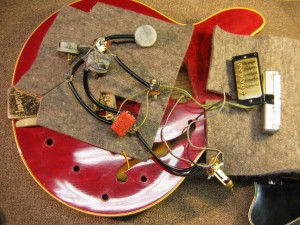
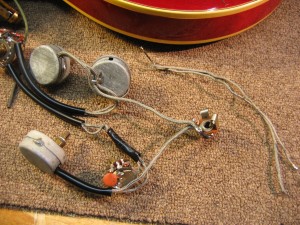
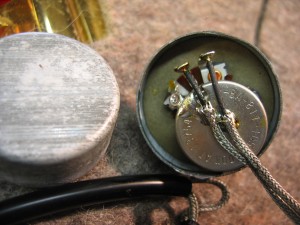
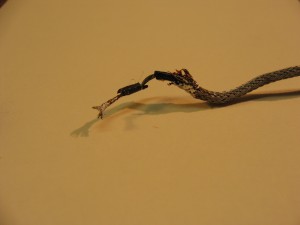
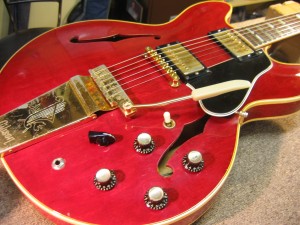
that’s both a great guitar, and a frustrating problem; i’m still trying to think up new ways to work inside hollowbodies, so suggestions and tricks are welcome– i’ve made a lot of little contraptions for pulling the jack back up through its hole, and my favorites are a ground down male 1/4″ jack on a length of old guitar cable, and one of those flexible pickup magnet arms, with a mini-neodymium magnet on either side of the jack. after you pull it through, just go back through the soundhole to collect the other magnet. i’d love to know what method you use. awesome blog!
Brian,
About 8 years ago I ground down a male plug at the end of a 2 foot piece of cable for jack-pulling purposes and it worked fine but kept pulling apart. So I soldered it one more time, crimped down the grounding tabs, and slathered epoxy over the wire and the plug. I haven’t used anything else in years. One of my favorite tools.
Could you please help me. I require a simplified block wiring (not the Gibson schematic) diagram for the Gibson ES345 stereo.
Thank you
Regards
Jimmy
:) good stuff
I have been repairing guitars for many years. There is some great information on guitar wiring here. I really enjoyed it. Keep up the good work.
Excellent work. I feel your pain with accessing tricky electronics. I’d bet the stereo output sounds amazing.
I love vintage things. I also play the guitar. It is also a good thing that you posted something like this one. It can help people who owned a 1965 GIBSON. Instead of looking for another guitar, it can be repaired. It saves money.
I’m looking for wiring info for the MCI B-35 Guitorgan S# 2570
can any one help ?
That guitar is really awesome. It just has that something which makes me excited about it. As a matter of fact, I am actually happy for the owner that you go to fix his guitar. Thank you for sharing this. I really enjoyed going through your post.
It could be worse. How many great old Gibson semis have been lovingly massacred by a big hole with new plastic cover on the back – just to check the wiring. It is a fiddly job, but I’ve done it several times. Nice work, and an even nicer guitar!